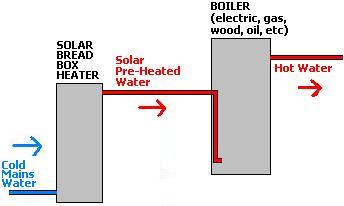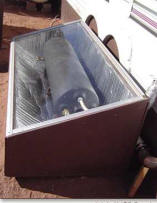There are many different types of solar water heater ranging from simple solar camping showers to whole house evacuated tube solar heating systems. Each type of system has its benefits and disadvantages and of course the variation in price can be extreme.
In this article we will look at solar Bread Box (aka Batch) heaters. These are very cheap to put together, very reliable, require no pump, controller or electricity, and can be put together with simple easy to source components.
Solar Bread Box Heater
A solar bread box heater can be used where mains water is available, and it pre-heats water before it reaches the boiler. (Note that this may not work with some combi boilers if their internal electronics often cannot deal with water over 30 degrees Celcius entering the boiler where it expects cold water to come in.)

Pictured above is a schematic of a bread box based solar water heating system. Mains water enters the solar heater at the bottom where it sits and gets heated up by the sun. When someone turns on the hot tap (drawing water from the boiler), the water warmed in the bread box is pushed (by mains water pressure) into the bottom of the boiler. Here it is heated further (if necessary) by the boiler until the water reaches the temperature set on the thermostat.

A standard electric water heating tank makes a perfect batch heater when it is painted black. This tank just needs to be fitted into a well insulated wooden box (or old fridge or freezer) with a glass window on one side through which the sun can shine. In the northern hemisphere the heater should be fitted facing southwards to maximise the solar radiation absorbed by the water in the tank.
Every degree you pre-heat water using such a bread box heater, is one degree you do not need to heat it with your boiler – therefore even the most basic system will save money and reduce your energy costs.
Additional Information
If you have a greenhouse then if the tank can be fitted high up near the apex of the roof, it is possible to get vast amounts of hot water for 9 months of the year at the same time as preventing the greenhouse from getting too hot.
In locations where frost is likely in the winter, ideally the batch heater (and pipework) should be fully drained so that no pipes burst. Mains water typically arrives at homes (in the UK) at around 5-7 degrees Celcius. Therefore, if it is cooler than that (and not sunny) outside, this heater would actually cool the water before it gets to the boiler. Since this is hardly ideal, a valve should be fitted so that you can manually configure the system to bypass the heater at these times.
For a basic guide to soldering copper pipe, click here.